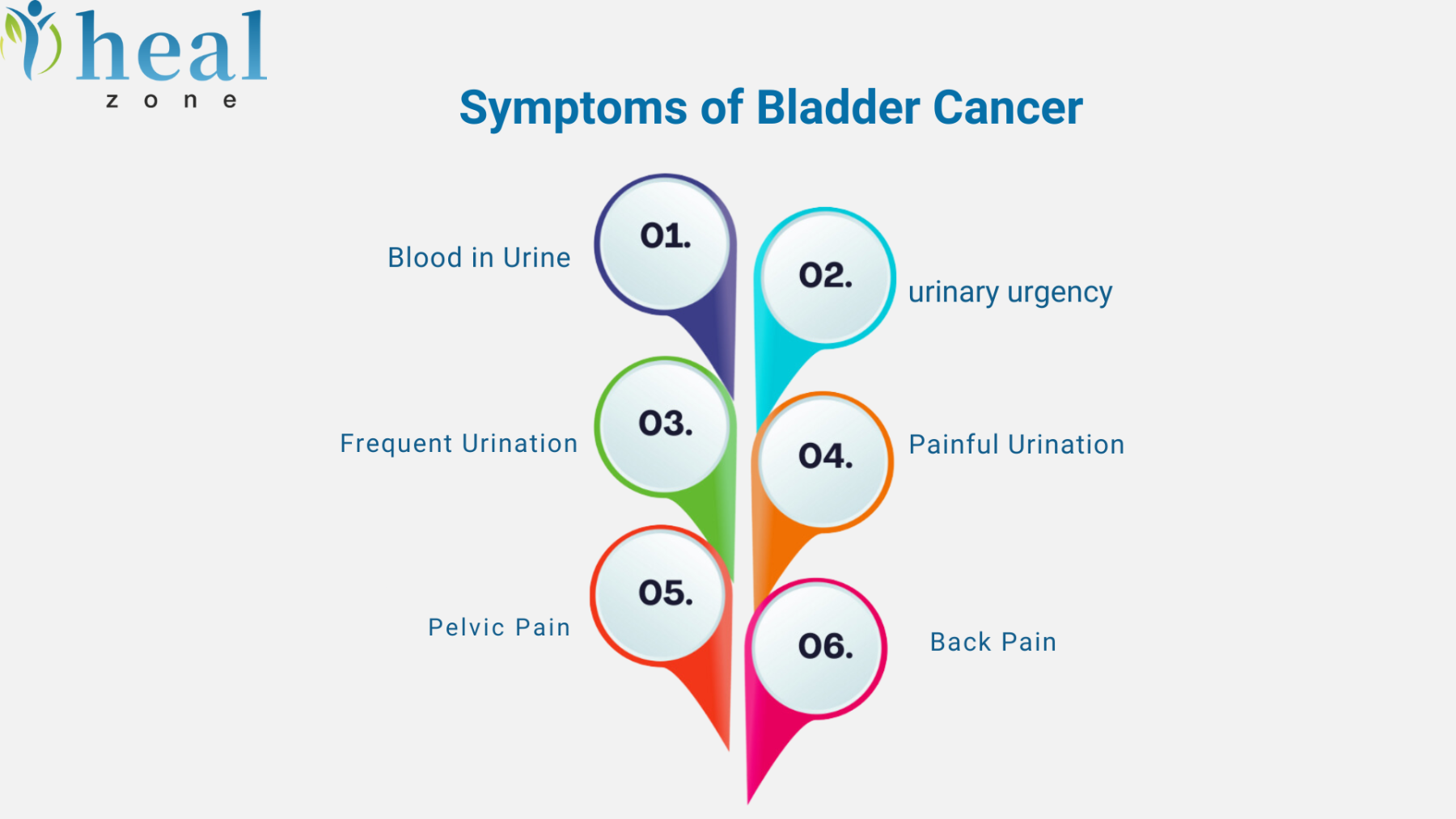Introduction
Bladder cancer is a significant health concern that affects thousands of individuals worldwide. Understanding the symptoms, diagnosis, and bladder cancer staging is crucial for early detection and effective bladder cancer treatment. In this blog post, we will explore the common symptoms of bladder cancer, the diagnostic procedures involved, and provide an overview of the staging systems used to determine the progression of the disease.
Symptoms of Bladder Cancer
Common Symptoms

Bladder cancer can present with various symptoms, some of which may be easily overlooked. The most common symptoms include:
- Hematuria (Blood in Urine): This is often the first noticeable symptom, where the urine appears pink, red, or cola-colored due to the presence of blood.
- Frequent Urination: An increased need to urinate more often than usual, particularly at night.
- Painful Urination: Discomfort or burning sensation during urination.
- Pelvic Pain: Persistent pain in the pelvic area.
- Back Pain: Pain in the lower back can be a symptom, especially if the cancer has spread.
When to Seek Medical Attention
It is essential to seek medical attention if you experience any of the symptoms mentioned above, particularly if they persist. Early detection of bladder cancer significantly improves the chances of successful bladder cancer treatment. Consulting a healthcare professional at the first sign of symptoms can lead to early diagnosis and better outcomes.
Diagnosis of Bladder Cancer
Initial Tests
The diagnosis of bladder cancer typically begins with a series of initial tests to identify the presence of cancerous cells:
- Urine Tests: Urinalysis and urine cytology are used to detect blood and cancer cells in the urine.
- Cystoscopy: A thin tube with a camera (cystoscope) is inserted into the bladder through the urethra to examine the bladder's interior and collect tissue samples for biopsy.
Advanced Diagnostic Procedures
If initial tests suggest the presence of bladder cancer, further diagnostic procedures may be performed to determine the extent and stage of bladder cancer:
- Imaging Tests: CT scans, MRI, and ultrasound are used to create detailed images of the bladder and surrounding structures, helping to identify the spread of cancer.
- Biopsy: During a cystoscopy, a biopsy may be taken to examine the tissue under a microscope and confirm the diagnosis of bladder cancer.
Stages of Bladder Cancer
Overview of Staging Systems
Bladder cancer staging is a critical step in determining the appropriate bladder cancer treatment plan. The TNM system is the most widely used staging system, categorizing cancer based on three key factors:
- Tumor (T): Size and extent of the primary tumor.
- Nodes (N): Whether the cancer has spread to nearby lymph nodes.
- Metastasis (M): Whether the cancer has spread to distant parts of the body.
.png)
Stage 0 to Stage IV Explanation
- Stage 0 (Non-invasive): Cancer cells are present on the bladder's surface lining but have not invaded deeper layers.
- Stage I: Cancer has spread to the connective tissue beneath the bladder lining but has not reached the muscle layer.
- Stage II: Cancer has invaded the muscle layer of the bladder.
- Stage III: Cancer has spread through the muscle layer to the surrounding fatty tissue and possibly to nearby reproductive organs.
- Stage IV: Cancer has spread to the pelvic or abdominal wall, lymph nodes, or distant organs such as the lungs, liver, or bones.
Role of Diet and Lifestyle in Bladder Cancer Treatment and Recovery
Maintaining a healthy diet and lifestyle plays a crucial role in the treatment and recovery process for bladder cancer patients. Proper nutrition, regular exercise, and mental well-being can significantly impact the effectiveness of treatment and improve overall quality of life.
Importance of a Healthy Diet and Lifestyle During and After Treatment
A balanced diet provides essential nutrients that support the body's ability to fight cancer and recover from treatments such as surgery, chemotherapy, and radiation. Staying active and maintaining a healthy weight can help manage side effects and reduce the risk of cancer recurrence. Additionally, mental well-being is vital for coping with the emotional challenges of a cancer diagnosis and treatment.
Tips on Nutrition, Exercise, and Mental Well-Being for Bladder Cancer Patients
- Nutrition: Focus on a diet rich in fruits, vegetables, whole grains, and lean proteins. Avoid processed foods, excessive sugar, and red meat. Stay hydrated and consider consulting a nutritionist for personalized dietary advice.
- Exercise: Engage in regular physical activity, such as walking, swimming, or yoga. Exercise can help boost energy levels, improve mood, and enhance overall physical health.
- Mental Well-Being: Practice stress-reducing techniques like meditation, deep breathing exercises, and mindfulness. Seek support from friends, family, or professional counselors to manage emotional stress and maintain a positive outlook.
Conclusion
Understanding the symptoms and diagnosis of bladder cancer is crucial for early detection and effective bladder cancer treatment. If you experience any symptoms, it is essential to seek medical attention promptly. Accurate diagnosis and bladder cancer staging enable healthcare providers to develop a tailored treatment plan that offers the best chance for successful outcomes. At Healzone, we are dedicated to providing comprehensive care and support to patients seeking medical tourism services in India, ensuring access to high-quality treatment and expert medical advice.
 Translate
Translate
 English
English  العربية
العربية  Русский
Русский  বাংলা
বাংলা 

